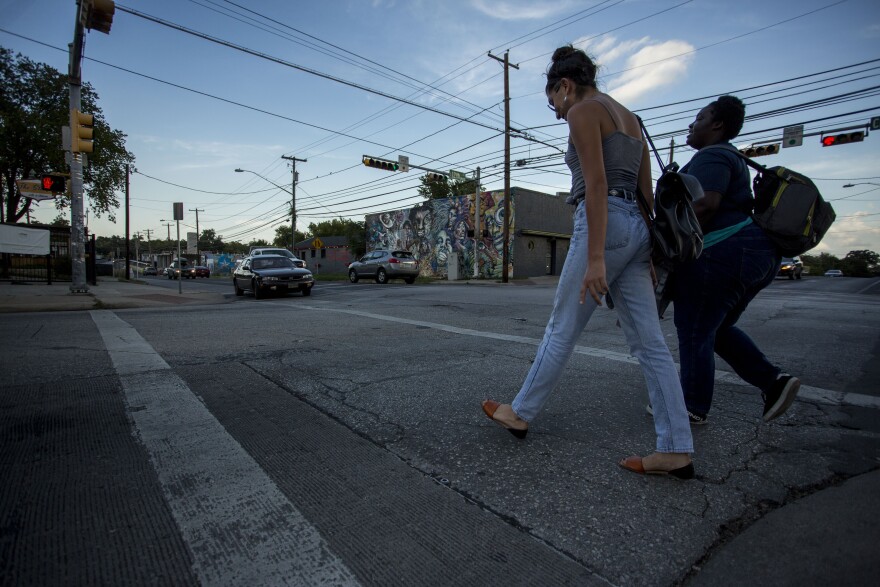Austin’s trolley cars, which retired in 1940, stopped at East 12th and Chicon streets. It’s there that Ada Harden and her brother would hop on, pay the five-cent fee, and ride with little concern about a destination.
“We’d go to the end of it and turn around and come back,” said Harden. She was born in 1935 and grew up in East Austin. Recently, she joined longtime East Austin residents Brenda Mims Malik and Creola Burns at a new co-working space, called Urban Co-Lab, at 12th and Chicon – one vivid change of many that have come to the area in the past few years.
"We had everything we needed right here. We had our schools, we had our businesses, we had our movies."
Despite its newness, Urban Co-Lab has fast become home to some big ideas: meetings to plan a first-of-its kind East 12th Street festival. The festival, which takes place this Saturday at 12th and Chicon, is an attempt at yet turning another chapter at one of the city’s most notorious intersections. The festival has been named “Return and Discover.”
“For those individuals who have moved away, and maybe that 12th and Chicon corridor is not something they experience on a day-to-day basis,” says Burns. Her father owned a mechanic shop in the area, Although Burns now lives in North Austin, she says she doesn't feel that it’s changed.
And when Burns talks about change, she talks about multiple changes since Harden’s time in the area. Back then, Harden’s father owned a service station and her aunt owned a café. She and Malik, 65, describe it as a tight-knit community – with a woman named Miss Josephine manning the local movie theater, the Harlem Theater
“I thought, the community ended at IH-35,” said Malik. “We had everything we needed right here. We had our schools, we had our businesses, we had our movies.”
And, in many ways, that was by design. Austin’s infamous 1928 Master Plan envisioned, and then made real, a “negro district” east of what is now I-35. But, despite a forced segregation, it was precisely desegregation of the schools that Malik said caused initial changes in the neighborhood – and not good changes.
It began with the closing of Austin’s original Anderson High School in 1971. Students were bussed to white schools as part of desegregation, and lost a school that Malik described as a hub of activity.
“We had what we needed, but integration just kind of separated all of us,” said Malik. “We lost a lot through integration.”

Families moved and there were fewer and fewer familiar faces in the neighborhood. Whereas before, there was a general moral code neighbors followed.
"If we saw someone doing something what they shouldn’t be doing on that corner, we would be free to be able to say something to them…and they would listen,” said Harden. “But, nowadays, you’re afraid to say anything to anybody on the corner.”
Years later, a 12th and Chicon more familiar to younger generations arose.
“If you wanted drugs you would come to the blue building at the corner of 12th and Chicon,” said Tim Pinson, who has owned Mission Possible Austin, a church on the corner of 12th and Chicon, since 2003. “The streets were lined with people selling their goods – either drugs or their bodies.”
In 2012, the Austin Police Department teamed up with nearby non-profits and churches, like Pinson’s church, to help low-level drug offenders get jobs. Some say the program was a success. Now, at 12th and Chicon, new businesses are joining the old – a new bar, King Bee, sits on the same block as longstanding Galloway’s Sandwich Shop. Just down Chicon Street towards 13th Street, condos are going up.
This is why Burns and others chose “Return and Discover” as the festival’s headline.
“Make a plan that, ‘I’m gonna go back to 12th Street today,’” said Burns. “I’m gonna return and discover what’s going on.”
"I’m going to stay here and do what I can, so we can be included."
The festival came out of a yearlong discussion to create a merchant district in the area, with help from the City of Austin’s Economic Development Department and the Soul-y Austin Business District Incubator. (The Red River Cultural District Merchants Association came out of this program partly after iconic music venues in the area shut down).
But Burns said the process has not been without pushback from some members of the community.
“We’ve had a couple businesses who have said they don’t want anything to do with our developing because they have been promised and promised and promised [things by the city] and nothing has happened,” said Burns. “So, they don’t feel like they want to invest the time.”
That’s fair, said Burns, for a part of town that has been neglected for so long, and has been the focus of so much attention recently – both from the city and real estate agents. Last year, the city hosted “The Spirit of East Austin,” during which Mayor Steve Adler said, “Today, we face east.”
For Burns, Harden and Malik, all three said, while the change may be out of their hands, they’re determined to be a part of it.
“I see change and I see growth,” said Burns.
“And we’re not included,” said Harden.
“I’m going to stay here and do what I can, so we can be included,” said Burns.
All three ran over each others’ words to say, “The spirit is still strong.”






